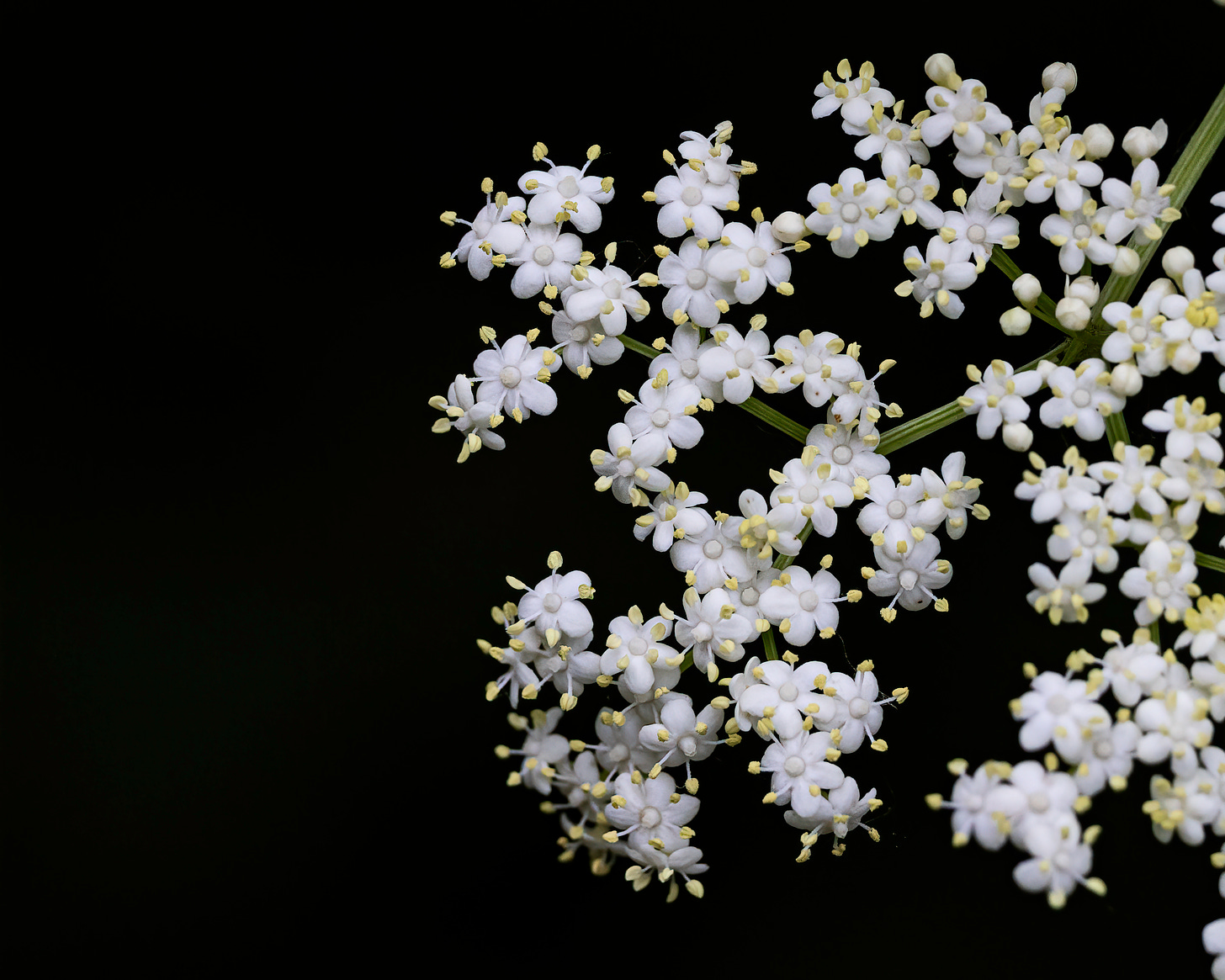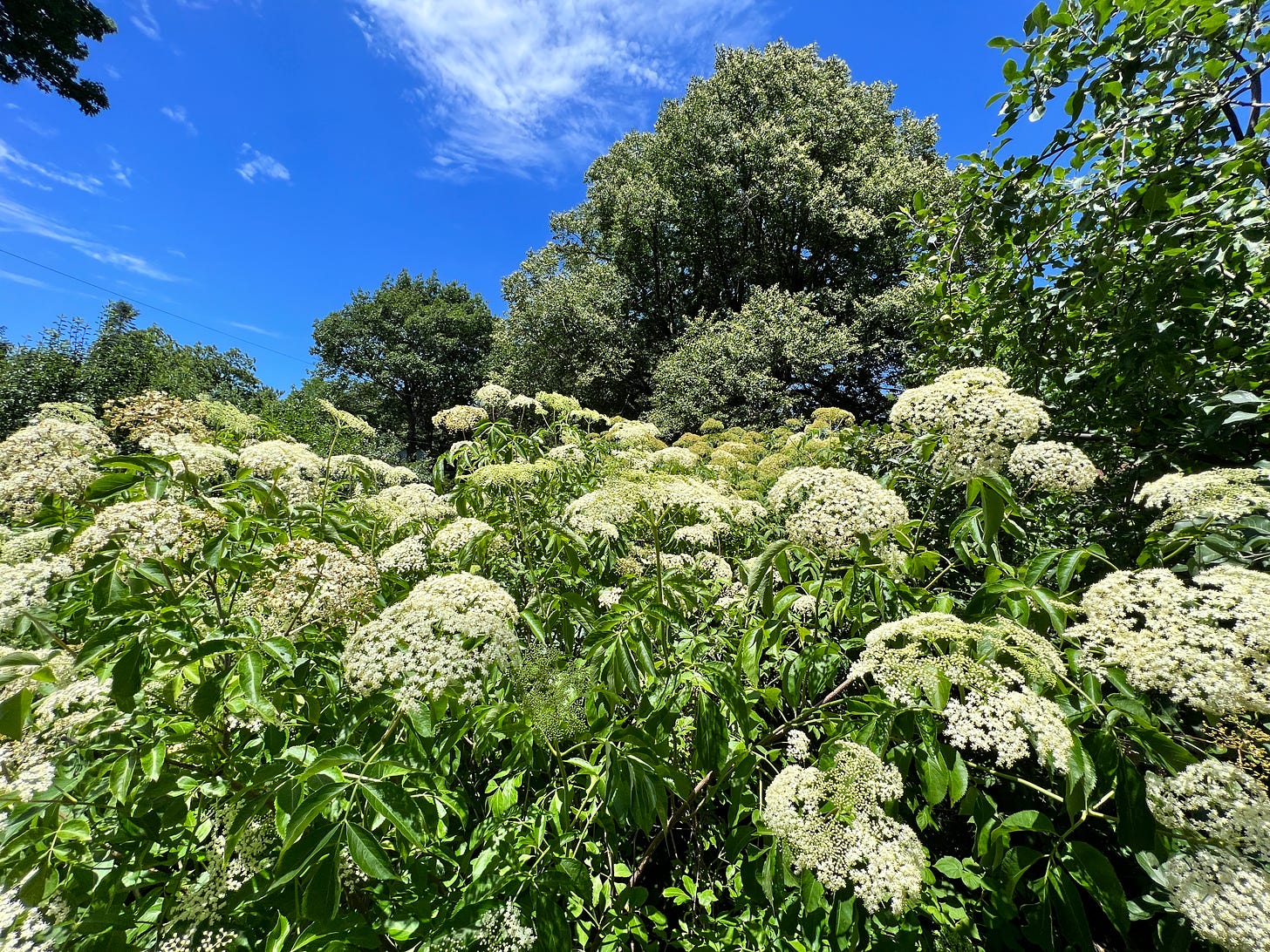Elderberries should be in every yard. This vigorous and adaptable native shrub has something for everyone. We are in the middle of harvest now, and we are overwhelmed by the abundance of berries. Fortunately, we are not the only ones that like to eat them. Over sixty species of birds eat elderberries. If you do not get to them, they quickly disappear.
One of the things that I most appreciate about elderberries is how easy they are to grow. They tolerate a wide range of soil types and conditions, but like most cultivated plants will do best in fertile soil. I have grown European and American elderberries, and I prefer the American Elderberry (Sambucus canadensis). They can be propagated by seed, root cuttings, and soft and hardwood cuttings. The most common method is hardwood cuttings. This involves taking a section of the stem cut from a dormant plant in winter, storing it in a bag in the fridge, and planting it in potting soil or directly into the soil in spring.
Cuttings are available from a variety of sources online. I order mine from River Hills Harvest. I grow a mix of cultivars, and so far, my favorite cultivar is Bob Gordon. Wyldewood is another good cultivar that produces large clusters of berries. Ranch is a short-statured cultivar that tolerates harsh conditions.
With a little watering and care, most cuttings will take root, and you will get to experience the power of elderberries. They will grow 6-9 feet in a year, flower, and produce fruit. The big white clusters of tiny flowers are beautiful and can be used in a variety of culinary and medicinal preparations.
Tiny green berries form as the flowers start to fade, and they quickly enlarge and turn red then purple as they ripen in mid-summer. Harvesting is relatively quick and easy. You just clip the clusters from the plant. I like to use Zensport ZS 104 or 105 Deluxe Scissors for this task.
Removing the berries from the stems is the next step in the process of making juice.
This article provides a good summary of our current understanding of glycosides in American elderberry. The researchers found no quantifiable trace of glycosides in commercial juice and safe levels in fresh fruit.
We spread the clusters out on cookie sheets and place them in the freezer for 30-45 minutes. The timing is important. If you get it right, the berries will be partly frozen and will easily separate from the stems. If you go too far and completely freeze the berries and stems, the stems will break and you will end up with more stem fragments mixed in with your berries. This is okay, but it takes more time to pick out the stems and is best avoided if possible. The stems also contribute to a less desirable flavor in the juice.
When you take your partly frozen berries out of the freezer, you just gently shake, squeeze, and pull apart the clusters and most of the berries will fall off on the cookie sheet. Then you pull apart the clusters and gently pull off the remaining berries. I like to roll them between my fingers and try to focus on the fully ripe berries, which are slightly easier to remove. If you get this motion down, you can leave the unripe and green berries on the stems. (Many flower clusters will contain a mix of unripe and ripe berries. This is normal.)
Now that you have a bowl full of berries, the last step is to pick out stems and unripe berries. Once you are satisfied or tired of prepping them, they can go into a pot with water. Many recipes include adding ginger, cinnamon, and honey.
You get different flavors based on how long you cook the berries and how hot the water gets. I like to keep the water around 190 degrees. This temperature range preserves the delicate flavor of the berries. If you boil them, you lose the subtle flavors. I bring the water with berries up to this temperature and hold it there for 1 to 3 hours. Over this time, you will gradually see the berries turn from purple to green as their pigments dissolve into the water. As the deep purple water cools, mesmerizing smoke floats across its surface.
I strain the berries and allow the juice to cool before adding honey, placing it in containers, and storing them in the freezer. Now you have your own immune-boosting syrup.









Wonderful, Bill. We've planted a few elderberries at our new place here. At our last place, there were some bumper crops occasionally (if we got ahead of the birds). One year, we made an elderberry-rhubarb pie. Crunchy, but good. Also, there's a river in western Maine we canoed several years back in the early fall, and we paddled along a mile of dense elderberries hanging over the bank. Never seen anything like it. We filled 2-gallon bags from the canoe, reaching up like Tantalus (but luckier). There was no shortage of waxwings around.
I loved this (as usual), Bill. To be truthful, the title "Elderberry Elexir" caught my eye. I'm quite fond of alliteration.....I didn't know much about elderberries except people in my old neighborhood said that it was a "dirty" tree" due to all the berries that it dropped. Silly! I had to have a 100 yo HUGE tree cut down in my back yard, and now have a space (next to my spice bushes). I'd like an elderberry, but would like it to stay around 5-6 feet. Recommendations? Aunt Carol